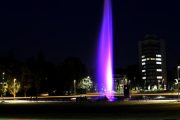How To Measure Light Intensity
1. What is light intensity
Light intensity is a physical term that refers to the luminous flux of visible light received per unit area. Abbreviated as illuminance, the unit is Lux or lx. The amount used to indicate the intensity of the light and how well the surface area of the object is illuminated.
In photometry, “luminosity” is the density of luminous intensity in a specified direction, but is often misunderstood as illuminance. The international unit of luminosity is the candle light received per square meter (called candela in mainland China, Hong Kong and Macau).
The illumination/illuminance on a surface illuminated by light is defined as the luminous flux per unit area.
Assuming that the luminous flux on the surface element dS is dΦ, the illuminance E on this surface element is: E=dΦ/dS .
1 lx=1 lm/㎡. An object that is uniformly illuminated by light has a luminous flux of 1 lumen on an area of 1 square meter, and its illuminance is 1 lux. Lumen is a unit of luminous flux.
A point light source with a luminous intensity of 1 candela has a luminous flux of “1 lumen” per unit solid angle (1 steradian).
The concept of Candela was first invented by the British, and it is a unit of Luminous intensity.
At that time, the British defined the unit of candlelight by the light emitted by a pound of white wax to make a one-foot-long candle. Today’s definition has changed: heating a black luminous body of one cubic centimeter until the luminous body melts into a liquid, 1/60 of the amount of light emitted is the standard light source, and candle light is the source of this standard light source. The unit of light emitted.

2. The significance of measuring light intensity
“Everything grows by the sun” is a well-known truth. It summarizes the huge role that light plays in the growth and development of organisms, especially plants, and the continuation of generations. As far as the photosynthesis of plants is concerned, as the name suggests, it is inseparable from light. . Only under the action of light can plants complete their unique life process—photosynthesis.
However, the photosynthesis of different plants responds differently to light intensity. For example, under the same light intensity, the absolute value of the photosynthetic rate (also called photosynthetic intensity) of different plants is significantly different. However, there are also similarities between different plants, that is, under a certain range of light intensities, the photosynthesis intensity of different plants all show an increase with the enhancement of light intensity. That is, the photosynthetic rate is positively correlated with the light intensity. In layman’s terms, when the light intensity is doubled or reduced by half, the photosynthetic rate also increases or decreases by half.
In nature, 24 hours a day and night is a light cycle. The time with light is the bright period, and the time without light is the dark period. In the case of natural light, the light time (bright period) is generally calculated by the time of sunshine; in the case of artificial light, the time of light irradiation is the light time, and the light period of 24 hours is the natural light period; the period of longer or shorter than 24 hours is called unnatural light. Period; if there is only one bright period and one dark period in 24h, it is called single-phase illumination; if there are two or more bright or dark periods in 24h, it is intermittent illumination. The sum of the bright periods in a light cycle is the light time.
Under direct sunlight in summer, the light intensity can reach 60,000 to 100,000 lx, 10,000 to 10,000 lx outdoors without the sun, 100 to 550 lx indoors in bright summer, and 0.2 lx under the full moon at night.
Incandescent bulbs emit about 12.56 lx of light per watt, but the value varies with bulb size, with small bulbs giving out more lumens and larger bulbs less. The luminous efficiency of fluorescent lamps is 3 to 4 times that of incandescent lamps, and the lifespan is 9 times that of incandescent lamps, but the price is higher. About 30% of the light emitted by an incandescent bulb without a lampshade is absorbed by walls, ceilings, equipment, etc.; the poor quality and darkness of the bulb will reduce many lumens, so only about 50% of the lumens are available. Generally, when there is a lampshade and the height of the lamp is 2.0-2.4m (the distance of the bulb is 1.5 times the height), 1W bulbs are required per 0.37㎡ area, or 2.7W bulbs are required per 1㎡ area to provide 10.76 lx. The height at which the bulb is installed and the presence or absence of a lampshade have a great influence on the light intensity.
In summary, light intensity has a great impact on plant growth and daily life. Therefore, research and learning to control light intensity are of great significance to human existence and life.

3. How to measure light intensity
In general, there is a commonly used formula for light intensity calculations suitable for indoor or stadium use:
Average illuminance (Eav) = total luminous flux of light source (N*Ф) * utilization factor (CU) * maintenance factor (MF) / area area (㎡)
Among them, the utilization coefficient is generally taken as 0.4 for indoor, 0.3 for sports, and 0.7 to 0.8 for maintenance coefficient.
But different places have different light intensity standards, such as 150LX for playing chess and cards; about 250LX for reading novels; about 500LX for writing; about 30LX for watching TV; 100000LUX in summer sunlight; Indoor fluorescent lamp is 100LUX; 60cm away from 60W table lamp is 300LUX; TV studio is 1000LUX; indoors at dusk is 10LUX; night street light is 0.1LUX;
The lighting required in the living room is 150-300Lux; the general study is 100Lux, but the lighting required for reading is 600Lux.
So how do we measure light intensity when we encounter various situations? This article will illustrate three possible methods.
(1) Pyranometer
A pyranometer is a high-precision sensor for measuring light intensity on a flat surface, which consists of two
It consists of a hemispherical glass top, a ferrous metal sheet as the absorbing surface under which the thermal elements are located, and then a self-ferrous metal enclosure. The sunlight travels vertically through the hemispherical glass dome to the absorbing surface and heats it up, and since the degree of heating is directly dependent on the light, the difference in temperature between it and the environment (or, more precisely, its white outer shell) can be used to calculate the light intensity.
The temperature difference is derived from a connected thermocouple, which gives a voltage proportional to the temperature difference, and a voltmeter is used to calculate the illumination from the voltage and a calibration factor. if pass
By installing a shading ring to filter out direct sunlight, it is also possible to measure scattered intensity.
The pyranometer has a high degree of precision, but because its operation is based on heat, the response is at least a little slow, and as a result, rapid fluctuations in light (eg, cloudy shadows) do not give satisfactory results. At a longer measurement time, the annual average level of measurement accuracy can reach 0.8 percentage points.
(2) Photoelectric sensor
The cost of photoelectric sensors is much lower than that of pyranometers, and crystalline silicon sensors are generally used.
device. Photoelectric sensors include a solar cell that generates a current proportional to the light. However, due to the spectral sensitivity of the sensor, the definite composition of the illumination cannot be accurately calculated, and the solar cell cannot measure long-wavelength infrared light. Depending on the calibration and sensor design, the annual average of the most accurate measurements can reach 2% to 5%. By calibrating and using a thin temperature sensor for temperature correction, an accuracy of better than 4% can be obtained.
Radiometers with photoelectric sensors are often used to monitor the operation of larger photovoltaic array systems.
It is worth mentioning that the sensor uses the same process as the battery (amorphous, single crystal, polycrystalline, cadmium telluride (CdTe) or copper indium selenide (CIS)), which increases accuracy and facilitates calculations. A data logger connected to a computing unit or inverter can compare the measured light intensity with the amount of electricity produced, which can determine how well the PV system is operating, showing the small measuring section on the sensor, direct and Temperature display, and data logger.
(3) Home-made photometric circuit
The light intensity is generally measured by an illuminometer, but this kind of instrument is expensive and generally used less frequently. If you don’t want to buy this kind of instrument, you can use a photoresistor and a digital voltmeter head to make a simple photometric circuit. According to the reading displayed on the digital voltmeter head, you can know the intensity of the light.
A simple light-controlled constant current source circuit is composed of triode VT, red LED and photosensitive electric anode RG. The constant current output by the VT collector will change with the intensity of the light. In the circuit, the voltage across the red LED is about 1.8V. And basically does not change with the power supply voltage, so the VT base voltage is stable.
The voltage of the emitting junction of the silicon tri-plate tube is generally about 0.6V, and it is basically unchanged, so the voltage applied to both ends of the RG is about 12V. In this way, the resistance of RG is different under different illumination, and the collector current of VT is also different. The stronger the light, the smaller the resistance of RG, the greater the collector current of VT, and the greater the voltage across the resistor R2, thus converting the light intensity into the voltage, so as long as the voltmeter is used to measure the R2 two The voltage at the terminal can know the light intensity.
The positive value of the photoresistor is related to the light intensity. The stronger the light, the smaller the resistance value, and has a better linear relationship, so it can be used as a light sensor to measure the intensity of light. When choosing a photosensitive electric limiter, it is best to choose a photoresistor with a smaller dark resistance.
To measure the voltage across the resistor R2, you can use a digital voltmeter head, which can work directly under 5V voltage. This measures the voltage across R2.
Since the voltage across R2 is proportional to the light intensity, the greater the voltage displayed by the voltmeter, the stronger the light intensity.
During production, the limit value of the resistance R2 can be adjusted according to the reading displayed by the illuminometer, so that the voltmeter can display the appropriate voltage.





